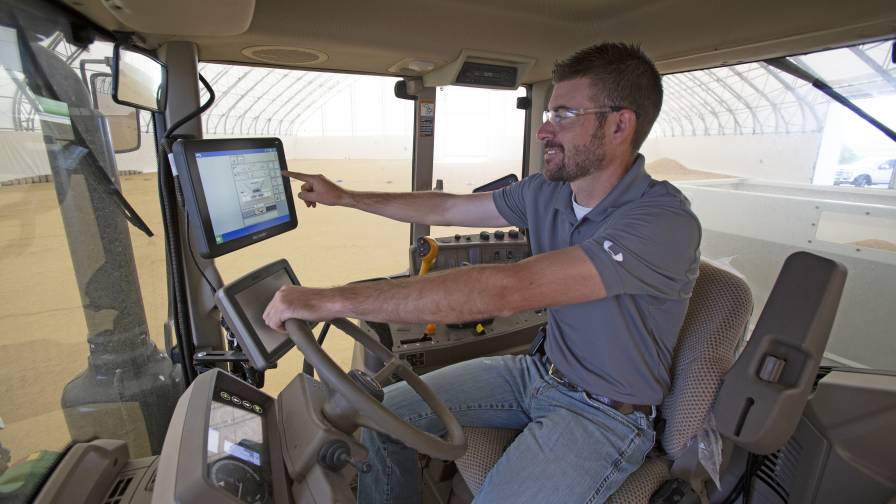The Tech Takeover: How Smart Technology Is the Driving Force Behind Today’s Application Equipment

New Leader’s smart technology solutions make operating equipment easier and more efficient.
If the start of 2024 is anything like the end of 2023, you won’t be able to open a magazine or turn on the television without hearing something about artificial intelligence or smart technology. Not only is agriculture not immune to the topic, manufacturers have embraced it and begun embedding it into equipment, mobile apps, and just about every other aspect of the industry.
John Deere has been a major advocate for equipment infused with smart technology.
“John Deere has been on this technology journey starting at farm level management, moving to field level, to zone level, and now at the plant level,” says Josh Ladd, Product Marketing Manager. “An example of how the technology has progressed is the John Deere sprayers. We moved to a zone-focus with section control and then advanced to individual row control with ExactApply. Now, we are optimizing each individual plant with See & Spray technology that uses artificial intelligence and machine learning. See & Spray Ultimate was launched in March 2022.”
When it comes to technology, it often seems that the moment it’s taken out the door it’s already obsolete. Manufacturers continue to add and improve the tools with each iteration.
“The See & Spray Ultimate targeted spray technology can help farmers reduce their non-residual herbicide use by more than two thirds and maintain a hit rate comparable to traditional broadcast spraying,” Ladd says. “For farmers, this decreased herbicide use can significantly lower herbicide costs, reduce tendering stops, and help them cover more acres per day. The technology continues to get better over time as the machine continues to learn and adapt from images. One example of this is we increased the speed from 12 to 15 mph for targeted application.”
The impact of all these new, intelligent tools can be a boon for efficiency and the bottom line.
“Of all the 2024 trends in digital agriculture, the role played by Gen AI, or generative AI, is likely to be one of the most significant,” says Ron Baruchi, CEO of Agmatix. “The potential of Gen AI on the global economy is already being calculated in trillions of dollars. There is a historic opportunity to optimize processes, cut costs, and importantly, fuel innovations through improved modelling to fuel decision-making.”
Agriculture is certainly going to be a major recipient of the benefits offered by smart technology and artificial intelligence. Though still in its infancy, smart technology can already be found in equipment in the field and the office.
“Companies are already using Gen AI through Digital Crop Advisors, allowing agronomists to distill agronomic data into actionable recommendations for farmers,” Baruchi says. “These tools enhance crop management by analyzing big agronomic data, providing AI-supported insights to optimize production practices. This helps farmers understand patterns affecting the performance of crop varieties and production on their specific farms, and tracks climate trends to help farmers become more resilient to the changing climate.”
Efficiency in the field is important to New Leader Manufacturing; smart technology helps the company do that. The company utilizes it to simplify the user experience. For years, operators encountered difficulties with finding the correct feed gate height for their field, product, or operating conditions. For example, New Leader’s Feed Gate Optimizer, which comes built into its ISOBUS interface, resolves that worry, the company says. It allows the operator to establish machine settings with ease.

Varda worked with Yara International to develop its Global FieldID and SoilHive smart technology solutions. Source: Esri, Maxar, GeoEye, Earthstar Geographics, CNES/Airbus DS, USDA, USGS, AeroGRID, IGN, and the GIS User Community
In addition to making the lives of growers easier, smart tech can have additional benefits. According to ag-tech start-up Varda, which provides farm and field data sharing solutions, technology can help deliver a “nature-positive food system.”
“Key to this mission is the need for improved field data insights and greater data granularity to enhance efficiency and foster better collaboration,” says Davide Ceper, CEO, Varda. “Our product, Global FieldID, is designed to provide a data infrastructure that enables farmers, agronomists, and agribusinesses to connect multiple digital farming tools and improve communication with external partners.”
Sure, tech is “cool” but if it doesn’t make growers’ operations easier and more efficient then it’s not likely to become widely accepted. That’s just one reason New Leader regularly consults end users.
“We are always looking to our customers for feedback. One consistent request is the need for machines to do more, be smarter and be simpler, while remaining user friendly.
“Finding the sweet spot between innovation and useability is a challenge we embrace,” says New Leader Manufacturing’s Rob Rudolphi. “While a newly developed machine may be cutting edge in theory, we can’t accept it if it’s cumbersome in practice. We take this into account during our research and development.”
The company works to continually improve its offerings. If a new idea leaves even one box unchecked, it’s a dealbreaker, or, at the very least, a pivoting point in the project, the company says.
“At every step of the way, we consider our dealers’ and ag retailers’ points of concern,“ New Leader’s Rudolphi says. “We look at those pain points and focus on crafting a solution. This customer-centric approach has led to us being an industry leader. Our customers know their feedback is heard and put directly into our solution-driven plan. We know their goal is to do as much as they can with as little as possible.”
This approach, the company says, boosts productivity and profitability. With an easy-to-use, pin-point accurate spreader, less time is spent in the field and less money is spent.
According to Varda’s Ceper, the new technologies that drive equipment and collect data can be used to better connect the supply chain, which will transform how food is grown and delivered.
“The food industry is in dire need of a digital infrastructure that connects farmers with other stakeholders in the agricultural supply chain, extending all the way to consumers,” Ceper says. “This necessity arises because a vast amount of data is generated on farms daily, but much of it remains isolated in silos, inaccessible, and cannot be shared efficiently or consistently.”
Per Ceper, a better-connected supply chain provides three key benefits:
- “It enhances the efficiency of farm operations,” he says. “Farmers can better manage and understand the timing for applying agricultural inputs. This capability includes maintaining a history of activities and nutrient applications on their fields, along with preserving all boundary history.
- “It boosts transparency and traceability in farming operations,” he continues. “This improvement enables farmers to share their practices with others and gain support for sustainable farming. In the future, the need to produce more food while conserving natural resources will become even more critical.
- “Collaboration is a vital aspect of sustainable food systems,” Ceper says. “Since data isolated in silos is ineffective, impactful actions cannot occur in isolation. All participants in the supply chain must collaborate, necessitating efficient communication. Global FieldID facilitates this communication among players in the food supply chain, promoting change and impactful actions.”
Agmatix’s Baruchi highlights several technologies he expects to see take off in 2024 and beyond.
Using Digital Twins to Optimize Field Trials: “An interesting 2024 trend is increased integration of digital twins into field tests and field test planning,” he says. “A digital twin is a digital model or a virtual representation of an actual physical product, system, or process. These allow researchers and designers to experiment as though they were handling its physical counterpart, reducing the need for expensive and time-consuming field trials.”
Innovation in Regenerative Agriculture: “Greater technical innovation and research into regenerative agriculture will continue over the coming year,” Baruchi says. “Essentially mimicking natural process and biodiversity on agricultural land, the ultimate aim of regenerative agriculture is to improve soil health in order to boost yield.”
Managing Data with Advanced Cloud Solutions: “Innovation in agriculture is often data-dependent and the cloud gives researchers the ability to collate, manage, and extrapolate information from data in a way that was previously unimaginable,” Baruchi says. “Anticipated exponential growth in farm data emphasizes the transformative impact — IDC has estimated that by 2036 the amount of data collected on the farm will increase by more than 800%. Cloud tools enabling real-time access to field trial data reduces trial duration and cost, and the volume and scope of trials can be increased.”
Innovation Across the Agricultural Spectrum: “Agriculture’s innovative history is turning towards sustainability and environmental protection, marking a transformative era,” Baruchi says. “The new year will see progress in climate-resilient crop development.
“At the farm level, digital technologies empower farmers to process and use the data they collect. AgTech solutions can help farmers and agronomists measure and demonstrate the return on investment of agricultural technologies. Amidst global challenges, stakeholders using AI and machine learning will drive unprecedented innovation in food production.”
Baruchi sums up the role these technologies will have on agriculture this way: “In 2024, the rise of Gen AI, impact of digital twins on field trials, and the evolution of cloud-based technologies will revolutionize the AgTech landscape. Various entities, including my own company, are using these cutting-edge technologies, crafting advanced software solutions to reshape the field of agronomy.”






